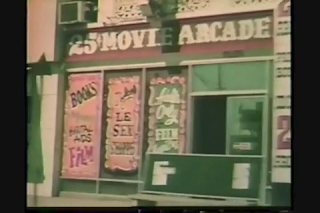Find more film reviews here.
Wolfgang Schmidt is actually a pseudonym for Ray Dennis
Steckler, who is best known for his 1963 movie “The Incredibly Strange
Creatures Who Stopped Living and Became Mixed-Up Zombies”. Steckler had numerous
aliases which included Sven Christian – credited here in a dual-role of
Cinematographer and Editor – and was well known for working on an extremely low
budget (sometimes just a few thousand dollars).
If you're into ultra low budget, down-and-dirty slasher
flicks, then you've come to the right place.
Click “READ MORE” below to continue the review and see
more screenshots...
“She wants it. They all want it. They like it. She
wants me to do it to her.” Pierre Agostino plays a sleazy photographer
scruffing around the seedy side of Los Angeles, and straight off the bat we're
thrown in at the deep end of his perversion. Within three minutes of starting
we've already notched up the first of many kills – his modus operandi:
strangulation, of course. His victims: a mix of prostitutes and amateur models found in grotty circulars like “Call Girls in L.A.” and “Hollywood
Models”.
“Honey, if you give me thirty bucks, I'll show you a
real good time.” This serial killer lives in a world of repetition,
seemingly spurred on by his sole motive, the unseen 'Marsha' – perhaps his
ex-wife/girlfriend – whom he considers to be a whore. The definition of madness
is doing the same thing over and over again while expecting a different outcome
– similarly, this voyeuristic stalker expects to find purity and love in the
same old places time after time, within the pages of call girl adverts, witness to a swathe
of broken dreams and low expectations.
“I was right, she is like all the others, worse
maybe.” That's only half the picture, so it is Carolyn Brandt (who
was married to Steckler for a decade, years prior to the making of this film)
who fills out the remainder of the title. Initially seen as the quiet
proprietor of a used book store, she's actually the Skid Row Slasher, who is
cleaning the streets of the boozed-up winos who stumble into her shop – and The
Hollywood Strangler can't get her out of his mind – unfortunately for him, he
can't even bring himself to speak to her. So begins a cycle of speechless
encounters and sexually frustrated murders.
“There's something about her, maybe she isn't like the
rest.” Made on the cheap (the very cheap), the script – or
rather “scenario”, as the end credits have it – has little to offer in depth or
variety. In total, fifteen kills are crammed into the 70 minute running time –
strangled models, drunkards with their throats sliced open, asphyxiated
prostitutes – it's all very formulaic, sticking close to a very defined
pattern. Kill, cleanse, stalk, kill cleanse, stalk, repeated for the duration to the point that yet another shot of The Hollywood Strangler petting his pigeons, or the Skid Row Slasher running on the beach, become like punchlines to a sinister joke.
“She looks so young and innocent, but she's no better
than a slut.” Arguably the film is misogynistic, with the bulk of the
victims being promiscuous young beauties in little or no clothing (most of
the actresses are evidently sourced from strip clubs and softcore productions) - although for a cheap exploitation movie that's honest about its purpose, that complicated term is perhaps rather unwieldy. Besides, serial killers are almost always white men who target women, and
considering that Steckler produced a string of softcore titles (such as Teenage
Massage Parlor, referenced via a poster in one model's apartment), the
link between sex & death as two extreme experiences is close. Slasher
movies, like softcore porno, offer a repeating cycle of events with a kill – or
a sex scene – at regular intervals, and The Hollywood Strangler Meets The
Skid Row Slasher is a prime example of how the formula crosses the
boundaries so effortlessly.
“The world has to be cleansed of its garbage.”
With incredibly low production values, the film is a scrappy piece of film-making
in many ways, but this weakness also offers some of its charm. The plot might
be a paper-thin excuse to show a procession of naked flesh snuffed out by a
psychopath, but there are some interesting moments of composition – for
example, as one victim walks unknowingly towards her doom, she is shown in an
extreme wide shot against an oppressively large wall of concrete. In the sleazy
areas of Los Angeles, the world consumes those who dare to set foot inside. That said, it's painfully obvious that the film was shot silent – the sparse dialogue is roughly synchronised in post, with the vast majority of it being internal monologues from inside The Hollywood Strangler's own warped mind.
“She looks good now, too bad I don't have film in my
camera, I'd really take her picture.” The
film stands as a great time piece for late 1970s Los Angeles – the seedy
side of the city is shown in all its gaudy and uncaring boldness – with much of
the post-kill scenes shot in a hasty, documentary style. The real-life citizens
of the time are glimpsed by Steckler's voyeuristic gaze – genuine prostitutes
striding past low-rent porno stores, wedding processions, and police cars that
just happened to pass by when his camera was rolling. Sexy roller discos for
swingers? Check. The most famous porn titles and names of the time on
grindhouse marquees? Check. Unkempt alleyways, back streets, and shop fronts?
Check. All caught in natural light, this is the dark side of L.A. writ large
and brandishing a genuine feel of shabbiness.
“Soon she'll be out of her misery.” In numerous
ways this film is rough as a badger's arse, and it's evidently cheap-as-chips
throughout, but there's a fascinatingly authentic sense of grit and grime
attached to it. Also, in spite of the threadbare script, there are curious
moments of disturbance for the viewer – is all the female dialogue inside the
Strangler's head? When he's prowling the streets photographing strangers and
sizing-up potential victims, does he even have film in his camera? There's a
convincing feel of madness throughout – the repetitive structure, Agostino's
dead-eyed gaze, that sense of doing the same thing over and over and expecting
a different result – and in the best way, you can't help but feel like washing
your hands after viewing it.
A sequel followed in 1987 titled The Las Vegas Serial Killer.
A sequel followed in 1987 titled The Las Vegas Serial Killer.

















%20001.jpg)





No comments:
Post a Comment